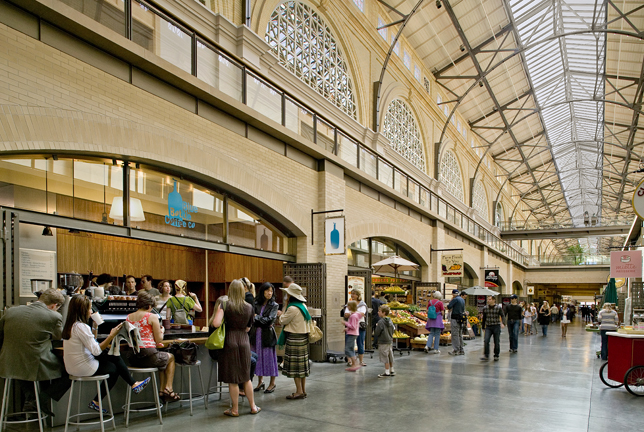
Although San Francisco’s Ferry Building has been around for 115 years, it celebrates its 10th birthday this year as a marketplace that serves as a port for three ferry lines. And the Ferry Building’s farmers market (Tuesday and Thursday from 10 a.m. to 2 p.m. and Saturday from 8 a.m. to 2 p.m.) also marked 20 years in May with a party where pastry chefs from around the city picked from the market’s seasonal produce to come up with a delectable selection of strawberry shortcakes. With the anniversaries abound, it’s the perfect time to visit this prominent San Francisco landmark. Here are five things you should know before you go.
1. Architecture. Originally constructed by architect A. Page Brown, the 660-foot building was completed in 1898. He created an arch theme throughout the building with arcades modeled after the aqueduct in Rome. The 245-foot clock tower, which chimes every hour and once on the half hour, is a replica of the bell tower in Spain’s Seville Cathedral. The massive steel-framed structure continues to stand today, even after surviving two earthquakes.
2. History. As the only entryway into San Francisco, the ferry building thrived until the 1930s, when the bridges became the primary means of arriving into the city. In the 1950s, a double-decker freeway enshrouded the building and cast the area into despair. After the 1989 earthquake destroyed the freeway, the city remembered the Ferry Building’s beauty. And even though it took 10 years of public dialogue, in 2003 the Ferry Building marketplace opened its doors with just two vendors: Peet’s Coffee and Tea and Recchiuti Confections. Both still have retail spaces in the building.
3. CUESA. Not only is the Ferry Building home to 46 retailers, eight office suites, a second floor that’s open to the public (which gives a bird’s-eye view of the shopping area below and has monuments and exhibits about the history of the building) and the Port of San Francisco, it also serves as ground zero for the Center for Urban Education about Sustainable Agriculture, or CUESA. The nonprofit, which was founded 20 years ago by Chez Panisse alum Sibella Kraus, manages the Ferry Plaza Farmers Markets.
The three weekly markets offer produce from more than 60 farmers and products from more than 30 artisans (such as New Orleans-style iced coffee from Blue Bottle, a variety of cheeses by Cowgirl Creamery and much more), and a whopping 1,500 varieties of fruits and vegetables. Education and events are what make CUESA’s farmers markets distinct. Each farm’s story features prominently on its stand and customers are encouraged to interact with the farmers. On Saturdays, chefs host cooking demos, and every Tuesday, there are Foodwise tours. For the latter, every week features a different theme and is led by a chef or farmer, and the tour highlights a market seller and closes with a sample of a dish from that vendor and a recipe to take home.
4. Chef spotting. If you’re hoping to see one of San Francisco’s top chefs, like Tyler Florence, Charles Phan, Michael Chiarello or Chris Cosentino, head to the Ferry Building and the Plaza Farmers Market. Three hundred and 73 toques participate in CUESA’s chef program. In fact, on a recent Tuesday morning, we spotted the aforementioned Cosentino with a camera crew in tow, along with two other chefs from city staples: Greens restaurant’s Annie Somerville and Hayes Street Grill’s Patricia Unterman.
5. The future. The Ferry Building continues to evolve and build upon its existing programs. The marketplace and CUESA both take pride in their incubation process, focusing on growing businesses. Many started out as small farms or food carts, but have grown into kiosks, market stalls or standalone brick-and-mortar spaces. The marketplace is also constantly searching for more artisans to feature, and in the next couple of months, Rancho Gordo New World Specialty Food and Humphry Slocombe artisanal ice cream will open shop. Another exciting development is the remodel of Boulette’s Larder, a Ferry Building institution that’s bringing in a pizza oven and an exquisite overall new dining experience. Other discussed future programming for the back plaza includes a Saturday antique fair, a night market and jazz on Sunday afternoons.
Photo Courtesy of CUESA

